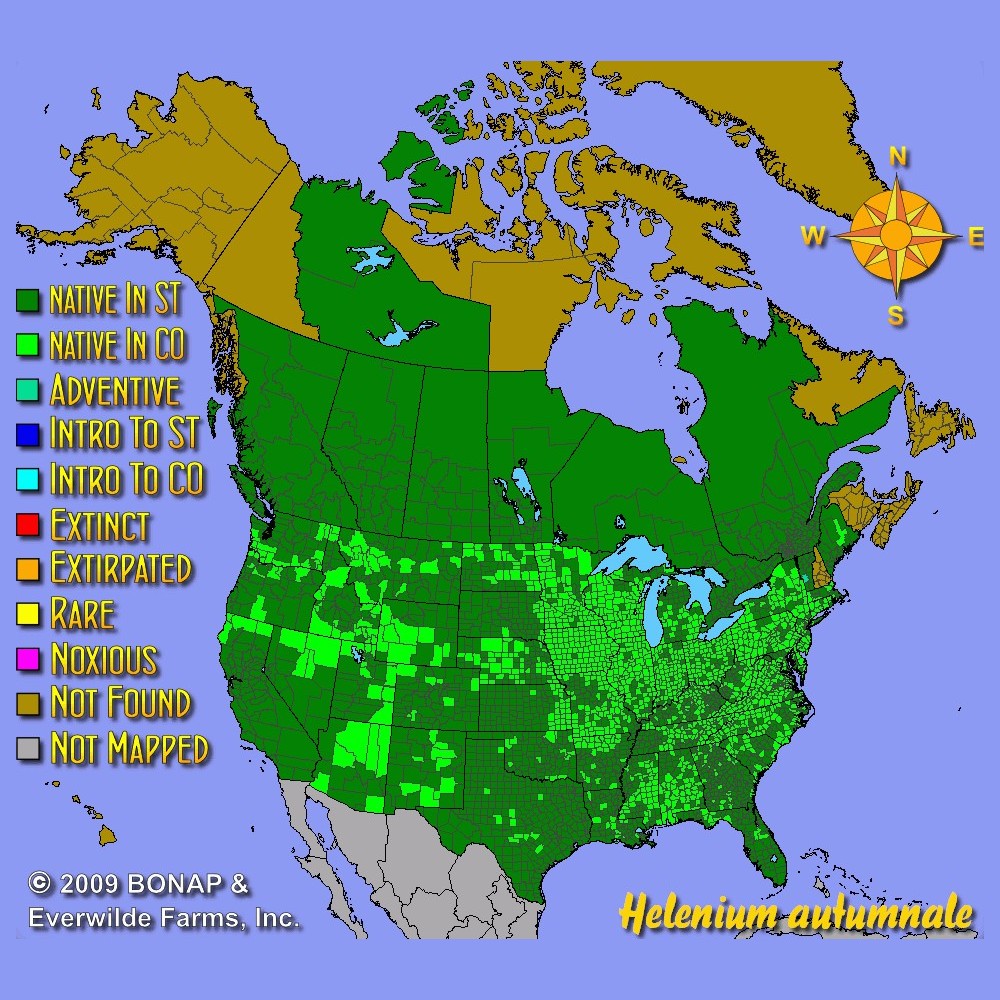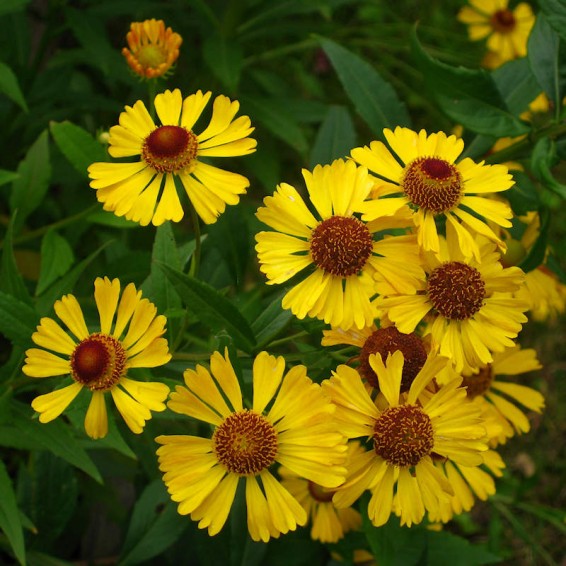Autumn Sneezeweed Seeds
- HOW TO GROW
- FAST FACTS
- REVIEWS
HOW TO GROW
Sowing: Direct sow in the spring, pressing the tiny autumn sneezeweed seeds in the surface of the rich soil and sprinkling a very thin layer of soil on top; this seed needs light to germinate. Mixing the seed with a small amount of sand may help in seed distribution. Keep the soil moist until germination, which usually occurs within 14-21 days. To start indoors, plant the seed on the surface of the soil in a flat; keep it lightly moist and at a temperature of 70 degrees F until germination. Transplant seedlings outdoors as soon as they can safely be handled.
Growing: Keep these plants consistently moist, since they do not tolerate drought conditions. This plant adapts well to clay soil or marshy areas. Though they usually require staking if they reach their full height, cutting the plants back in mid-summer will produce a more compact and bushy plant that does not need support. Deadheading will help the plant produce the greatest amount of blooms; cut the plant back by half after it finishes flowering. Mature plants can be divided after three or four years of growth. This plant attracts bees and butterflies and resists deer and rabbits.
Harvesting: For fresh flowers, cut long stems of flowers that have just opened and place them in water immediately; strip the leaves that will fall below the water.
Seed Saving: After the petals drop off, the domed centers will turn a mature golden brown; as soon as the stems just below the heads begin to turn brown, remove the heads. Spread them out to dry for several days, then shake or rub them lightly to remove the seeds. Clean the Helenium Autumnale seeds as well as possible, but keep in mind that the chaff attached to each seed will not affect germination. Store the autumn sneezeweed seeds in a cool, dry place.
FAST FACTS
Common Names: Common Sneezeweed, Helen's Flower, Dogtooth Daisy, Bittersweet
Latin Name: Helenium autumnale
Species Origin: US Native Wildflower
Type: Native Wildflowers
Life Cycle: Perennial
USDA Zones: 2, 3, 4, 5, 6, 7, 8, 9, 10
US Regions: California, Mountain, Arid/Desert, Plains/Texas, Midwest, Northern, Northeast, Southeast
Seeds per Ounce: 100,000
Stratification: No Stratification
Germination Ease: No Stratification
Sunlight: Full Sun, Part Sun
Height: 48 Inches
Color: Yellow
Bloom Season: Blooms Early Fall, Blooms Late Fall
Uses: Attracts Pollinators, Attracts Butterflies, Aromatic, Cut Flowers, Deer Resistant
Great seeds
I know the autumn sneezeweed will be beautiful next summer and fall. Everwilde has a great selection and I will buy from them again.
Sneezeweed seeds
Prompt delivery of excellent seeds of sneezeweed and coreopsis in very attractive resealable packets that will serve to hold dried seeds in the fall.
DESCRIPTION

HOW TO GROW
Sowing: Direct sow in the spring, pressing the tiny autumn sneezeweed seeds in the surface of the rich soil and sprinkling a very thin layer of soil on top; this seed needs light to germinate. Mixing the seed with a small amount of sand may help in seed distribution. Keep the soil moist until germination, which usually occurs within 14-21 days. To start indoors, plant the seed on the surface of the soil in a flat; keep it lightly moist and at a temperature of 70 degrees F until germination. Transplant seedlings outdoors as soon as they can safely be handled.
Growing: Keep these plants consistently moist, since they do not tolerate drought conditions. This plant adapts well to clay soil or marshy areas. Though they usually require staking if they reach their full height, cutting the plants back in mid-summer will produce a more compact and bushy plant that does not need support. Deadheading will help the plant produce the greatest amount of blooms; cut the plant back by half after it finishes flowering. Mature plants can be divided after three or four years of growth. This plant attracts bees and butterflies and resists deer and rabbits.
Harvesting: For fresh flowers, cut long stems of flowers that have just opened and place them in water immediately; strip the leaves that will fall below the water.
Seed Saving: After the petals drop off, the domed centers will turn a mature golden brown; as soon as the stems just below the heads begin to turn brown, remove the heads. Spread them out to dry for several days, then shake or rub them lightly to remove the seeds. Clean the Helenium Autumnale seeds as well as possible, but keep in mind that the chaff attached to each seed will not affect germination. Store the autumn sneezeweed seeds in a cool, dry place.
FAST FACTS
Common Names: Common Sneezeweed, Helen's Flower, Dogtooth Daisy, Bittersweet
Latin Name: Helenium autumnale
Species Origin: US Native Wildflower
Type: Native Wildflowers
Life Cycle: Perennial
USDA Zones: 2, 3, 4, 5, 6, 7, 8, 9, 10
US Regions: California, Mountain, Arid/Desert, Plains/Texas, Midwest, Northern, Northeast, Southeast
Seeds per Ounce: 100,000
Stratification: No Stratification
Germination Ease: No Stratification
Sunlight: Full Sun, Part Sun
Height: 48 Inches
Color: Yellow
Bloom Season: Blooms Early Fall, Blooms Late Fall
Uses: Attracts Pollinators, Attracts Butterflies, Aromatic, Cut Flowers, Deer Resistant
Reviews
Review
Great seeds
I know the autumn sneezeweed will be beautiful next summer and fall. Everwilde has a great selection and I will buy from them again.
Review
Sneezeweed seeds
Prompt delivery of excellent seeds of sneezeweed and coreopsis in very attractive resealable packets that will serve to hold dried seeds in the fall.






